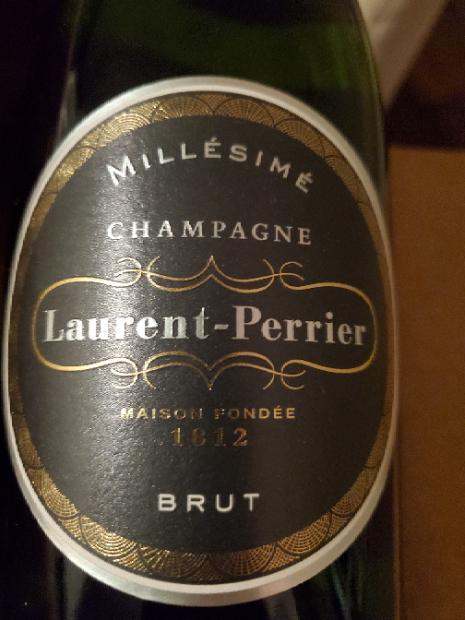
External search
Google (images)
Wine Advocate
Wine Spectator
Burghound
Wine-Searcher
Vintages
2022
2012
2011
2008
2007
N.V.
From this producer
Show all wines
All tasting notes
|
| Drinking Windows and Values |
| Drinking window: Drink between 2010 and 2014 (based on 1 user opinion) |
| Community Tasting History |
| Laurent-Perrier Producer website
Laurent-Perrier: Innovator in Champagne
The Laurent-Perrier style is grounded in the vision of one man,
Bernard de Nonancourt, who began creating champagnes
underpinned by freshness, finesse and elegance as early as the
1950s.
Above and beyond the style, what defines the House of
Laurent‑Perrier is its role as an innovator and pioneer in ensuring
of the quality of wines in Champagne. In 1959, Laurent-Perrier
created Grand Siècle, a blend of three exceptional vintages that
complement each other perfectly to recreate the perfect year.
In 1968, Laurent-Perrier introduced Cuvée Rosé elevating
non-vintage rosé champagne through a totally new type of wine.
In 1981, Laurent-Perrier launched Ultra Brut as the perfect
complement to nouvelle cuisine long before the “Brut Nature”
category was even created.
In 1987, Laurent-Perrier presented an exceptional marriage
between Pinot Noir and Chardonnay with Alexandra Rosé vintage
champagne.
In 2017, Laurent-Perrier unveiled the evolution of its Brut Non-Vintage,
“La Cuvée”, showcasing significant advances in quality.
In 2019, Laurent-Perrier innovated with Blanc de Blancs Brut
Nature, no dosage, by perfecting its knowledge of stainless steel
vat vinification.Champagne Blend"Champagne blend" is a classic grape blend that typically includes Chardonnay, Pinot Noir and/or Pinot Meunier in any proportions.
However, this blend can also include Arbane, Fromenteau (Pinot Gris), Petit Meslier and/or Pinot Blanc as well.Bruthttp://en.wikipedia.org/wiki/Sweetness_of_wineFrance Vins de France (Office National Interprofessionnel des Vins ) | Pages Vins, Directory of French Winegrowers | French Wine (Wikipedia)
Wine Scholar Guild vintage ratings
2018 vintage: "marked by a wet spring, a superb summer and a good harvest"
2019 vintage reports
2021: "From a general standpoint, whether for white, rosé or red wines, 2021 is a year marked by quality in the Rhône Valley Vineyards. Structured, elegant, fresh and fruity will be the main keywords for this new vintage."
2022 harvest: idealwine.info | wine-searcher.comChampagne Le Champagne (Le comité interprofessionnel du vin de Champagne) | Grandes Marques & Maisons de Champagne (Union des Maisons de Champagne)
France - When it comes to wine, France stands alone. No other country can beat it in terms of consistent quality and diversity. And while many of its Region, Bordeaux, Burgundy and Champagne most obviously, produce wine as rare, as sought-after and nearly as expensive as gold, there are just as many obscurities and values to be had from little known appellations throughout the country. To learn everything there is to know about French wine would take a lifetime. To understand and appreciate French wine, one only has to begin tasting them. Click for a list of bestselling items from all of France.
Sub-Region:
Champagne - The French region of Champagne (including the cities of Rheims, Épernay, and Aÿ) was the first region in the world to make sparkling wine in any quantity. Today, the name of the region is synonymous with the finest of all sparkling wines, and wine-making traditions of Champagne have become role models for sparkling wine producers, worldwide. Surprisingly, the region of Champagne is now responsible for only one bottle in 12 of all sparkling wine produced. Styles of champagne range in sweetness ranging from an extra brut or brut 0, to the basic brut to demi sec to doux; some houses produce single vintage champagnes and others produce non-vintage (or incorporate wines/grapes of multiple vintages), often to preserve a specific taste; combinations of grape varietals; and colors, including a rosé. There are several sub-appellations, including the Valley of the Marnes river running from Épernay west, Massif de Saint-Thierry north and west of Rheims, Valley of the Ardre, the Mountains of Rheims (between Rheims and Épernay), Côte des Blancs, Côte de Sézanne, and Côte des Bar in the South. Champagne wine only uses three grape varietals (cépages): Chardonnay, Pinot Noir, and Pinot Meunier.ChampagneThe vineyards of Champagne on weinlagen-info |
|




